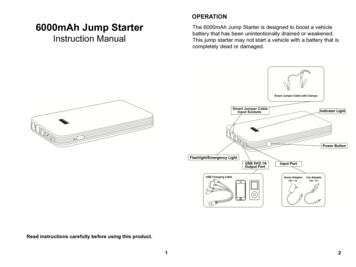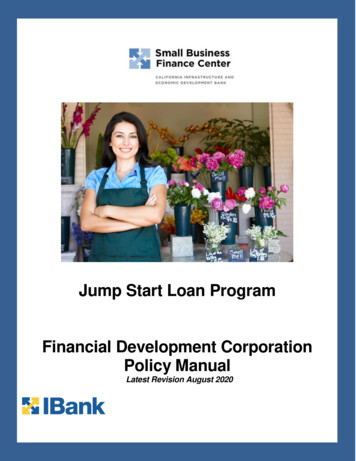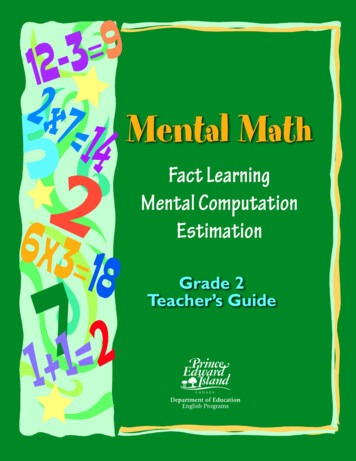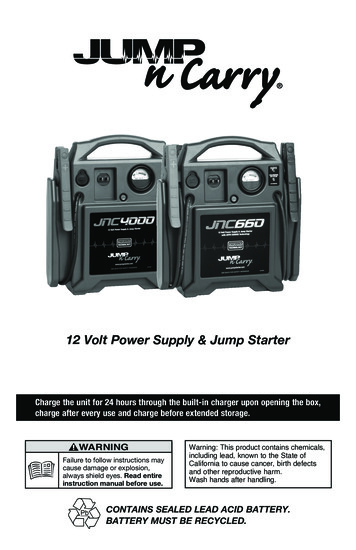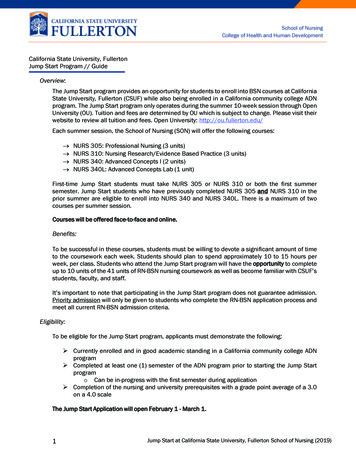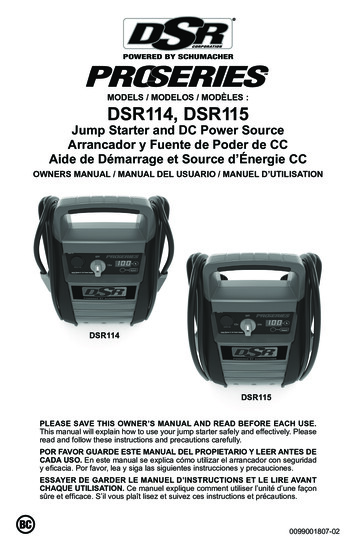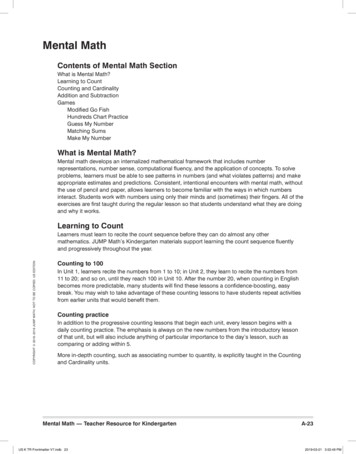
Transcription
Mental MathContents of Mental Math SectionWhat is Mental Math?Learning to CountCounting and CardinalityAddition and SubtractionGamesModified Go FishHundreds Chart PracticeGuess My NumberMatching SumsMake My NumberWhat is Mental Math?Mental math develops an internalized mathematical framework that includes numberrepresentations, number sense, computational fluency, and the application of concepts. To solveproblems, learners must be able to see patterns in numbers (and what violates patterns) and makeappropriate estimates and predictions. Consistent, intentional encounters with mental math, withoutthe use of pencil and paper, allows learners to become familiar with the ways in which numbersinteract. Students work with numbers using only their minds and (sometimes) their fingers. All of theexercises are first taught during the regular lesson so that students understand what they are doingand why it works.Learning to CountCOPYRIGHT 2016–2019 JUMP MATH: NOT TO BE COPIED. US EDITIONLearners must learn to recite the count sequence before they can do almost any othermathematics. JUMP Math’s Kindergarten materials support learning the count sequence fluentlyand progressively throughout the year.Counting to 100In Unit 1, learners recite the numbers from 1 to 10; in Unit 2, they learn to recite the numbers from11 to 20; and so on, until they reach 100 in Unit 10. After the number 20, when counting in Englishbecomes more predictable, many students will find these lessons a confidence-boosting, easybreak. You may wish to take advantage of these counting lessons to have students repeat activitiesfrom earlier units that would benefit them.Counting practiceIn addition to the progressive counting lessons that begin each unit, every lesson begins with adaily counting practice. The emphasis is always on the new numbers from the introductory lessonof that unit, but will also include anything of particular importance to the day’s lesson, such ascomparing or adding within 5.More in-depth counting, such as associating number to quantity, is explicitly taught in the Countingand Cardinality units.Mental Math — Teacher Resource for Kindergarten A-23US K TR Frontmatter V7.indb 232019-03-21 3:53:49 PM
Counting and CardinalityIn developing a sense of numeracy, most students will learn to say the counting sequence in order,but without assigning meaning. Next, they acquire an understanding of one-to-one correspondence(one number for each object being counted). The third step is an understanding of cardinality (thelast number said is the number of objects in the group and is independent of the order in which theobjects are counted). Once this understanding is solidified, learners can be encouraged to subitize(identify without counting) and name quantities. Furthermore, students can begin to comparequantities and numbers.Our materials support this process. We proceed through Counting and Cardinality first within 5,then within 10, within 20, and within 100 to the degree expected by the Common Core StateStandards. Students who learn in an atypical fashion will have ample opportunity to revisitconcepts when they are ready to assimilate them. The counting and cardinality checklists thatfollow (see p. A-25) list the required skills in the order in which they are usually acquired. Whenassessing student progress, keep in mind that some students will learn differently.Most students will begin to acquire Skills 1–5 in Unit 1 and should have mastered them by the endof Unit 4. Skill 6 is taught explicitly in Unit 13 but will be acquired much earlier by most students.Skill 1: Saying the Count Sequence to 5Skill 2: Recognizing Numerals to 5Skill 3: Understanding One-to-One CorrespondenceSkill 4: Understanding CardinalitySkill 5: Subitizing 1–3 ObjectsSkill 6: Subitizing 4–5 ObjectsCOPYRIGHT 2016–2019 JUMP MATH: NOT TO BE COPIED. US EDITIONStudents are ready to practice Skills 7–9 after Unit 4.Skill 7: Saying the Count Sequence to 10Skill 8: Naming Numbers 0 to 10Skill 9: Counting Out Objects to 10Students are ready to practice Skills 10–12 after Unit 10.Skill 10: Saying the Count Sequence to 20Skill 11: Counting Organized Objects to 20Skill 12: Saying the Count Sequence to 100A-24 US K TR Frontmatter V7.indb 24Mental Math — Teacher Resource for Kindergarten2019-03-21 3:53:49 PM
Counting and Cardinality Checklist #1RecognizingNumerals to rrespondenceSubitizing1–3 ObjectsSubitizing4–5 ObjectsCOPYRIGHT 2016–2019 JUMP MATH: NOT TO BE COPIED. US EDITIONStudent NameSayingthe CountSequenceto 5Mental Math — Teacher Resource for Kindergarten A-25US K TR Frontmatter V7.indb 252019-03-21 3:53:49 PM
Counting and Cardinality Checklist #2NamingNumbers0 to 10Counting OutObjects to 10Sayingthe CountSequenceto 20CountingOrganizedObjects to 20Sayingthe CountSequenceto 100COPYRIGHT 2016–2019 JUMP MATH: NOT TO BE COPIED. US EDITIONStudent NameSayingthe CountSequenceto 10A-26 US K TR Frontmatter V7.indb 26Mental Math — Teacher Resource for Kindergarten2019-03-21 3:53:49 PM
Addition and SubtractionOne of the greatest gifts you can give students is to expose them to number facts. Learners canbegin to mentally add and subtract numbers in a short time if they are offered daily practice in afew basic skills. Beginning with fluent counting, these skills then progress to number comparisonand early addition and subtraction skills, such as composing and decomposing, and operationswithin 5. The addition and subtraction checklist that follows (see p. A-28) lists the required skillsin the order in which they are taught in our materials. Again, when assessing student progress,keep in mind that some students will learn differently.Students are ready to practice Skill 1 after Unit 2.Skill 1: Comparing Numbers 1 to 5Students are ready to practice Skill 2 after Unit 5.Skill 2: Comparing Numbers 1 to 10Students are ready to practice Skills 3–4 after Unit 8.Skill 3: Adding 0Skill 4: Adding 1Students are ready to practice Skill 5 after Unit 10.Skill 5: Naming Numbers to 20COPYRIGHT 2016–2019 JUMP MATH: NOT TO BE COPIED. US EDITIONStudents are ready to practice Skills 6–7 after Unit 13.Skill 6: Adding within 5Skill 7: Subtracting within 5Mental Math — Teacher Resource for Kindergarten A-27US K TR Frontmatter V7.indb 272019-03-21 3:53:49 PM
Addition and Subtraction ChecklistComparingNumbers1 to 5ComparingNumbers1 to 10Adding 0Adding 1NamingNumbersto 20Addingwithin 5Subtractingwithin 5COPYRIGHT 2016–2019 JUMP MATH: NOT TO BE COPIED. US EDITIONStudent NameA-28 US K TR Frontmatter V7.indb 28Mental Math — Teacher Resource for Kindergarten2019-03-21 3:53:49 PM
GamesModified Go FishPurposeIf students know the pairs of one-digit numbers that add up to particular target numbers, they willbe able to mentally break sums into easier sums. Kindergarten students should learn pairs to 5 andto 10.Example: Since it is easy to add any one-digit number to 10, you can add a sum more readilyif you can decompose the sum so that it includes pairs of numbers that add to 10.7 5 7 3 2 10 2 12These numbers add to 10.To help students remember pairs of numbers that add to a given target number, we have developeda cooperative version of Go Fish as well as a competitive version. We recommend that studentsplay the cooperative version with each other in groups of 2–4. If you choose to use the competitiveversion, we recommend having a caring adult play with each individual student. The adult canbuild the student’s confidence by allowing the student to win as many times as the adult feels isnecessary. We do not recommend that students play the competitive version with each other.The Cooperative GameObject of the Game: To make and lay down pairs of cards that add to 5Materials: Four sets of cards numbered 1 to 4COPYRIGHT 2016–2019 JUMP MATH: NOT TO BE COPIED. US EDITIONThe player to the left of the dealer starts the game. To decide the first dealer, pick a student at random.The dealer gives each player 3 cards and puts the remaining cards face down into a draw pile. Ifplayers have any pairs of cards that add to 5 (e.g., one and four, two and three), they place thesepairs on the table before play begins. If any player is left with no cards at this point, that playertakes a card from the pile.Player 1 selects one of the cards in her hand and asks Player 2 for a card that adds to 5 with thechosen card. For example, if Player 1’s chosen card is a three, she asks Player 2 for a two.If Player 2 has the requested card, he must give it to Player 1. Player 1 puts the resulting pair downimmediately. If Player 2 doesn’t have the requested card, he says “Go fish,” and Player 1 picks acard from the draw pile. If this card adds to 5 with a card in Player 1’s hand, she lays the pair downright away.If Player 1 has no cards left, she takes a card from the draw pile.Now it is Player 2’s turn to ask for a card from Player 3, and so on. On each turn, players ask for acard from the next player or pick one from the draw pile. On each turn, players may also set downany extra pairs in their hands.Play ends when the draw pile runs out. At the end of the game, players are allowed to put down anypairs that remain in their hands. The team wins if, together, they have made the required number ofpairs between them.Mental Math — Teacher Resource for Kindergarten A-29US K TR Frontmatter V7.indb 292019-03-21 3:53:49 PM
Scaffolding: Some students have trouble sorting their cards and finding pairs that add to 5. If this isthe case, give the student only three cards, two of which add to 5. Ask the student to find the pairthat adds to 5. After the student has mastered this step, repeat the exercise with four cards, thenfive cards, and so on.You can also give a student a list of pairs that add to 5. As the student gets used to the game,gradually remove pairs from the list so that the student learns the pairs by heart.The Competitive GamePlay as above with the following changes: Play ends when one player lays down all of his or her cards. This player receives four points.Players then receive one point for each pair they have laid down. The goal of the game is toscore as many points as possible. Players get another turn if the player from whom they request a card has it.Different Target NumbersGo Fish is easily adapted to finding pairs that add to 10. Simply use cards numbered 1 to 9 andplay as before.Hundreds Chart PracticePut a blank hundreds chart (or a hundreds chart with pockets) on the board. Place five numbers onthe chart. Ask volunteers to place other numbers. The volunteers can find the correct spot for theirnumbers either by counting up from 1 or by counting on from one of the numbers you have placed.Guess My NumberCOPYRIGHT 2016–2019 JUMP MATH: NOT TO BE COPIED. US EDITIONTell students that you are thinking of a number between 1 and 10. Students are allowed to askquestions such as “Is your number less than 5?”, “Is your number equal to 6?”, and “Is yournumber greater than 2?” until they find your number. For a more advanced version of the game, usehigher numbers. You might also use a hundreds chart and allow students to ask questions aboutthe chart. For example, if you use numbers up to 30, a student might point to a row of the hundredschart and ask “Is the number in this row?”NOTE: The following games involve addition and subtraction and are therefore more advanced andshould only be played later in the year.Matching SumsMake a set of cards with sums (3 1, 2 2, 1 1, 4 2, and so on) and a set of cards withanswers to the sums. Place three of the sums in a column on the board. Place the answers in acolumn beside the sums, but not necessarily in the same order. Ask a volunteer to draw lines toconnect each sum to its answer. You can increase the level of difficulty by placing more cards in thecolumns or using larger sums. Encourage students to find the answers using concrete materials(their fingers, blocks, or pictures) and then, eventually, from memory.Make My NumberWrite a number on the board and ask a volunteer to tell you a sum that gives the number. Askstudents to find as many answers as possible. For example, if you chose the number 5, somepossible answers are 3 2, 1 4, 4 1, and 0 5. For a more advanced version of the game,allow students to use more than two numbers in their sums (for example, 1 2 2 makes 5) orallow them to use subtraction (7 – 2 makes 5).A-30 US K TR Frontmatter V7.indb 30Mental Math — Teacher Resource for Kindergarten2019-03-21 3:53:49 PM
What is Mental Math? Mental math develops an internalized mathematical framework that includes number representations, number sense, computational fluency, and the application of concepts. To solve problems, learners must be able to see patterns in numbers (and what violates patterns) and make appropriate estimates and predictions. Consistent .
